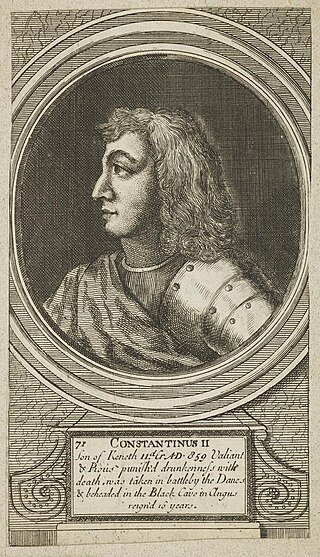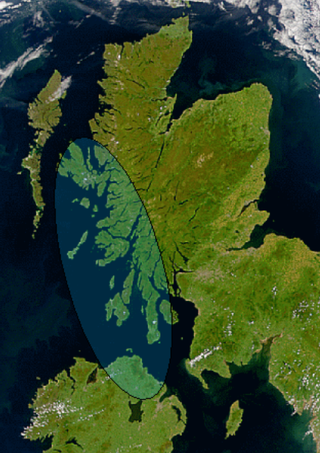Related Research Articles

Causantín mac Cináeda was a king of the Picts. He is often known as Constantine I in reference to his place in modern lists of Scottish monarchs, but contemporary sources described Causantín only as a Pictish king. A son of Cináed mac Ailpín, he succeeded his uncle Domnall mac Ailpín as Pictish king following the latter's death on 13 April 862. It is likely that the reign of Causantín witnessed increased activity by Vikings, based in Ireland, Northumbria and northern Britain. He died fighting one such invasion.

Áedán mac Gabráin, also written as Aedan, was a king of Dál Riata from c. 574 until c. 609 AD. The kingdom of Dál Riata was situated in modern Argyll and Bute, Scotland, and parts of County Antrim, Ireland. Genealogies record that Áedán was a son of Gabrán mac Domangairt.

Bridei son of Beli, died 692 was king of Fortriu and of the Picts from 671 until 692. His reign marks the start of the period known to historians as the Verturian hegemony, a turning point in the history of Scotland, when the uniting of Pictish provinces under the over-kingship of the kings of Fortriu saw the development of a strong Pictish state and identity encompassing most of the peoples north of the Forth.
Nechtan grandson of Uerb, was king of the Picts from 595 to around 616, and may be the same person as the Neithon son of Guipno who ruled the kingdom of Altclut.
Gartnait, son of Domelch, was a king of the Picts from 584 to 595.
Ceretic Guletic of Alt Clut was a king of Alt Clut, associated with Dumbarton Castle in the 5th century. He has been identified with Coroticus, a Brittonic warrior addressed in a letter by Saint Patrick.
Eugein or Ywain was a ruler of Alt Clut, a Brittonic kingdom based on Dumbarton Rock, sometime in the mid-7th century. According to the Harleian genealogies, he was the son of Beli I, presumably his predecessor as king, and the father of Elfin, who ruled sometime later. The Annals of Ulster and the Annals of Tigernach record another probable son, Dumnagual, who ruled Alt Clut and died in 694. Eugein was probably the brother or half brother of Bridei III of the Picts, the victor at the Battle of Dun Nechtain.
Elfin was a ruler of Alt Clut, a Brittonic kingdom based on Dumbarton Rock, sometime in the later 7th century. According to the Harleian genealogies, he was the son of Eugein I, one of his predecessors as king, and the father of Beli II, who ruled some time later. Very little is certainly known of him, though he may be identifiable with other figures attested in the Irish annals, and circumstantial evidence may link him to a number of important events during this time.
Beli II was a king of Alt Clut, a Brittonic kingdom based on Dumbarton Rock, for some period in the early 8th century.
Teudebur of Alt Clut was the ruler of Alt Clut, in the early-to-mid eighth century. According to the Harleian genealogies, he was the son of Beli II, his probable predecessor as king. Such information is confirmed by both the Irish and Welsh annals. We know from the Harleian genealogy that he was the father of Dumnagual III, one of his successors. His reign coincided with that of the illustrious Pictish king Óengus mac Fergusa. The Annales Cambriae reports that in 750, the Britons defeated a Pictish army at Mocetauc (Mygedawc), in which, according to the Annals of Tigernach, Óengus' brother Talorgen was killed. Mygedawc is often identified with modern Mugdock, on the boundary between Dunbartonshire and Stirlingshire, but this identity is by no means certain. The Annals of Tigernach, which styles him Taudar mac Bile, rí Alo Cluaide, put his death at 752, and for this reason, we can be certain Teudebur was the British king responsible for the British victory.
Dumnagual III was a king of Strathclyde in the mid-eighth century. According to the Harleian genealogies, he was the son of Teudebur, one of his predecessors.
Eugein II may have been ruler of Alt Clut, the Brittonic kingdom later known as Strathclyde, for some time in the late-8th century. He is known only from the Harleian genealogies, which indicate that he was the son of King Dumnagual III of Alt Clut; there is no direct evidence that he ruled as king himself. Dumnagual is presumed to be the monarch who submitted to the joint army of Kings Óengus I of the Picts and Eadberht of Northumbria in 756; after this event, Alt Clut seems to have remained under foreign power and the royal line is known exclusively through the Harleian genealogies for more than a century. If Eugein was king, he may have been in power during the "burning of Ail Cluaithe" recorded in the Annals of Ulster as having occurred in 780. According to Harleian, he was the father of Riderch II.
Riderch II was, according to the Harleian genealogies, the son of Eugein II, the son of King Dumnagual III of Alt Clut. He is known only from this source, and there is no direct evidence he was king of Alt Clut, although he is usually regarded as such by scholars. The Harleian genealogies indicate he was the father of Dumnugual IV, evidently his successor as king.
Dumnagual IV was a 9th-century British figure thought to have been a ruler of Alt Clut, the kingdom later known as Strathclyde. According to the Harleian genealogies, he was the son of his predecessor Riderch II, the grandson of Eugein II, and the great-grandson of King Dumnagual III of Alt Clut. He is known only from this source, and there is no direct evidence he was king of Alt Clut, although he is usually regarded as such by scholars. The Chronicle of the Kings of Alba reports the burning of Dunblane by the Britons in the year 849, and it is possible that Dumnagual was the British ruler responsible for the act, though it is equally possible that his son Artgal was responsible.
Gartnait son of Donuel was king of the Picts from 657 until 663.
Drest son of Donuel was king of the Picts from c. 663 until 672. Like his brother and predecessor Gartnait son of Donuel, and Gartnait's predecessor Talorgan son of Eanfrith, he reigned as a puppet king under the Northumbrian king Oswiu. Gartnait and Drest may have been sons of Domnall Brecc, who was king of Dál Riata from c. 629 until he was killed in 642.
Talorg son of Uuid was a king of the Picts from 641 to 653.
Gwid son of Peithan was a warband leader allied with the northern Britons fighting against the Angles of Northumbria in the early 7th century, recorded in the Welsh poem Y Gododdin. He is described in Y Gododdin as a "steadfast warrior" and may have been either a southern Pict or a northern British chief.
References
- Anderson, Alan Orr, Early Sources of Scottish History: AD 500–1286, 2 Vols, (Edinburgh, 1922).
- Smyth, Alfred P. (1984), Warlords and Holy Men: Scotland AD 80–1000, Edinburgh: Edinburgh University Press, ISBN 0-7486-0100-7
- MacQuarrie, Alan, "The Kings of Strathclyde", in A. Grant & K.Stringer (eds.) Medieval Scotland: Crown, Lordship and Community, Essays Presented to G.W.S. Barrow, (Edinburgh, 1993), pp. 1–19.
- Williams, Anne, Smyth, Alfred P., and Kirby, D.P., (eds.), A Biographical Dictionary of Dark Age Britain, (London, 1991), s.v. "Nechtán", p. 183